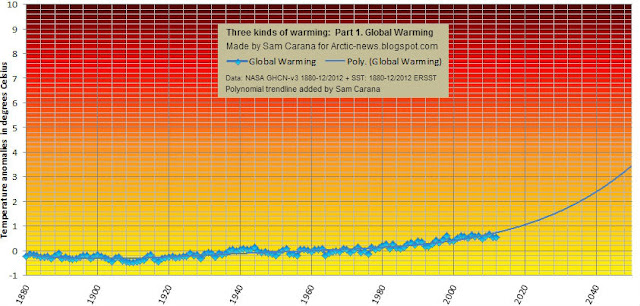 |
Earth and paleo-climate science, Australian National University
IPCC Reviewer
The global CO2cide 400 ppm milestone
 |
| Figure 1. Mouna Loa Month ending May 1, 2013, from: http://keelingcurve.ucsd.edu/ |
 |
| Figure 2. CO2 levels over the past 800,000,000 years, from: http://keelingcurve.ucsd.edu/ |
 |
| Figure 3. Mouna Loa CO2 level 29 April, 2013 keelingcurve.ucsd.edu/ |
This followed a rise from 394.45 ppm to 397.34 ppm (March 2012 – 2013) at a rate of 2.89 ppm per year, unprecedented in the recorded geological history of the last 65 million years (Figure 4).
Pliocene temperatures - about 2 – 3 degrees C warmer than pre-industrial temperatures, resulted in an intense hydrological cycle, ensuing in extensive rain forests, lush savannas (now occupied by deserts), small ice caps and sea levels about 25 meters higher than at present (Figure 5).
 |
| Figure 4. CO2 rise rates vs Temperature rise rates for the Cainozoic (65 Ma to the present). |
 |
| Figure 5. The Pliocene Earth compared to the modern Earth http://www.giss.nasa.gov/research/features/199704_pliocene/page2.html Note (1) the lower albedo in the Pliocene poles signifying the smaller size of the ice caps and (2) the high albedo of the modern Sahara and Gobi deserts signifying the a larger extent of Holocene deserts. |
Gradual to intermittent advents of Pleistocene ice ages over the last 2 million years allowed many species to adapt to changing conditions. Abrupt warming events, such as the DansgaardOeschger cycles, occurred during glacial periods (Figure 4). Extreme shifts in state of the climate exceed the rate to which many species can adapt.
The basic laws of atmospheric physics and chemistry and the behavior of past atmospheres indicate changes in the level of atmospheric greenhouse gases constitute a key parameter determining the current trend of the terrestrial climate. Concomitant rates of SO2 release, mainly from coal burning, have regulated changes in temperature.
Increases in SO2 release about 1950 and 2001 are responsible for slow-down of temperature rise (Figure 6).
 |
| Figure 6. Comparison of the rate of warming and variations in SO2 levels. Temperature from GISS/NASA (http://data.giss.nasa.gov/gistemp/); SO2 levels after http://www.atmos-chemphys.net/11/1101/2011/acp-11-1101-2011.html. Note the overlap between slow-down of overall temperature rise rates and increase in SO2 emissions (http://www.atmos-chem-phys.net/11/1101/2011/acp-11-1101-2011.html) around 1950 and 2001. |
The K-T asteroid impact of 65 Ma-ago resulted in a rise of more than 2000 ppm CO2 within about 10,000 years, namely ~0.2 ppm /year. This triggered a temperature rise of about 7.5 degrees C, namely 0.00075 degrees C per year (Beerling et al. 2002 http://www.pnas.org/content/99/12/7836.full) (Figure 4). Calculations by these authors suggest a release of approximately 4500 billion tons of carbon from impacted carbonates and shale, ignited bushfires and ocean warming.
The consequences of the current rise in greenhouse gases is manifested by enhancement of the hydrological cycle, with ensuing floods and of heat waves (http://www.ipcc-wg2.gov/SREX/ ; http://www.aph.gov.au/Parliamentary_Business/Committees/Senate_Committees?url=ec_ctte/extreme_weather/index.htm).
Open-ended combustion of known fossil fuel reserves (Figure 7) would lead to atmospheric CO2 levels of ~800 to 1000 ppm CO2, high degree to total melting of the polar ice caps, sea level rise on the scale of tens of meters and disruption of the biosphere on a scale analogous to recorded mass extinctions (http://www.astrobio.net/interview/2553/under-a-green-sky).
 |
| Figure 7. CO2 emissions by fossil fuels (1 ppm CO2 ~ 2.12 GtC). Alternative estimates of reserves and potentially recoverable resources are from EIA (2011) and GAC (2011). We are headed toward 800 to 1,000+ ppm, which represents the near-certain destruction of modern civilization as we know it -- as the recent scientific literature makes chillingly clear. (http://thinkprogress.org/climate/2012/01/28/413955/james-hansen-on-cowards/). |
Preoccupied with short-term economic forecast, daily A$ exchange rates, share market fluctuations and, sports results, with some exceptions (http://www.theage.com.au/national/greenhouse-gases-in-new-danger-zone-20130428-2imjm.html) the accelerating rate of atmospheric CO2 seems to hardly rate a mention on the pages of the global media.
There are few signs the extreme danger the terrestrial biosphere and the oceans are driving the global community to undertake the urgent large-scale measures required to attempt to arrest current trends.
In Australia the language has changed, from “the greatest moral issue of our generation” (http://www.youtube.com/watch?v=CqZvpRjGtGM) to hit-pocket controversy over a “carbon tax”, a meningless 5 percent reduction in local emissions which overlook the export of hundreds of million tons of coal, ending up in the same atmosphere.
There is no evidence the recent IPA celebration (http://www.crikey.com.au/2013/04/05/abbottbolt-rinehart-fawn-in-the-ipa-court-of-king-murdoch/), attended by the likely next prime minister, the world’s media moguls and mining magnates, as well as an archbishop, was concerned with the future of the Earth’s climate.
In professor Hans Joachim Schellnhuber’s words stated in Doha “overriding everything else the 1st Law of Humanity: Don’t kill your children!” (http://www.pik-potsdam.de/news/inshort/files/Schellnhuber-keynote-COP18-state-dinner-Doha.pdf).
There is no planet B.



















